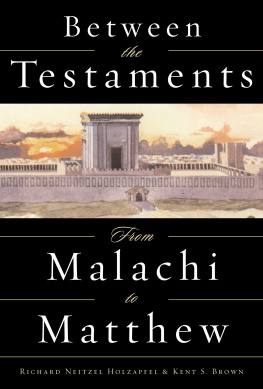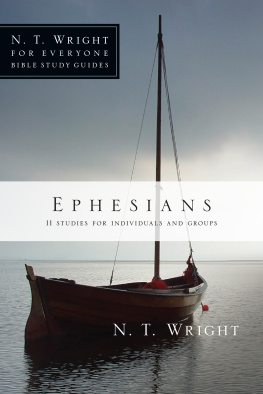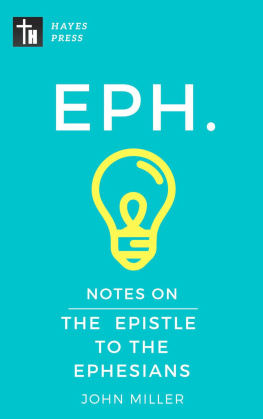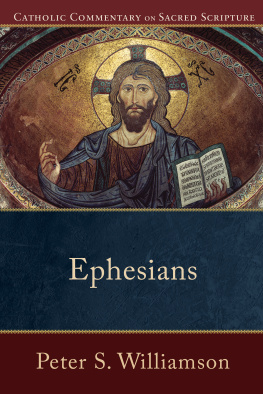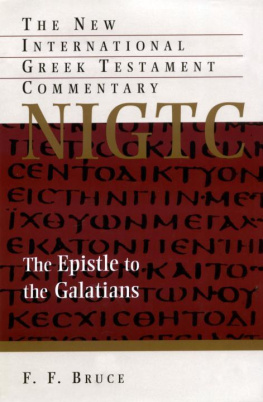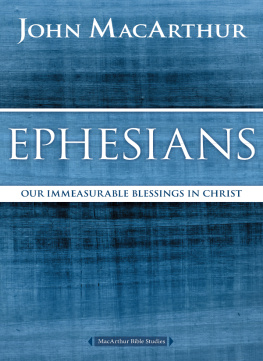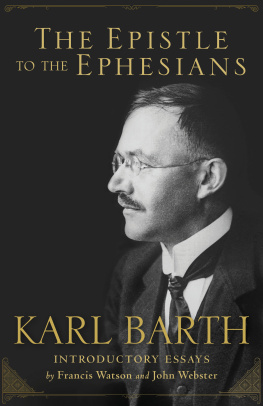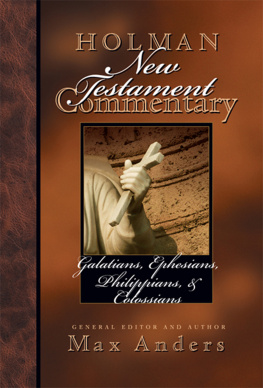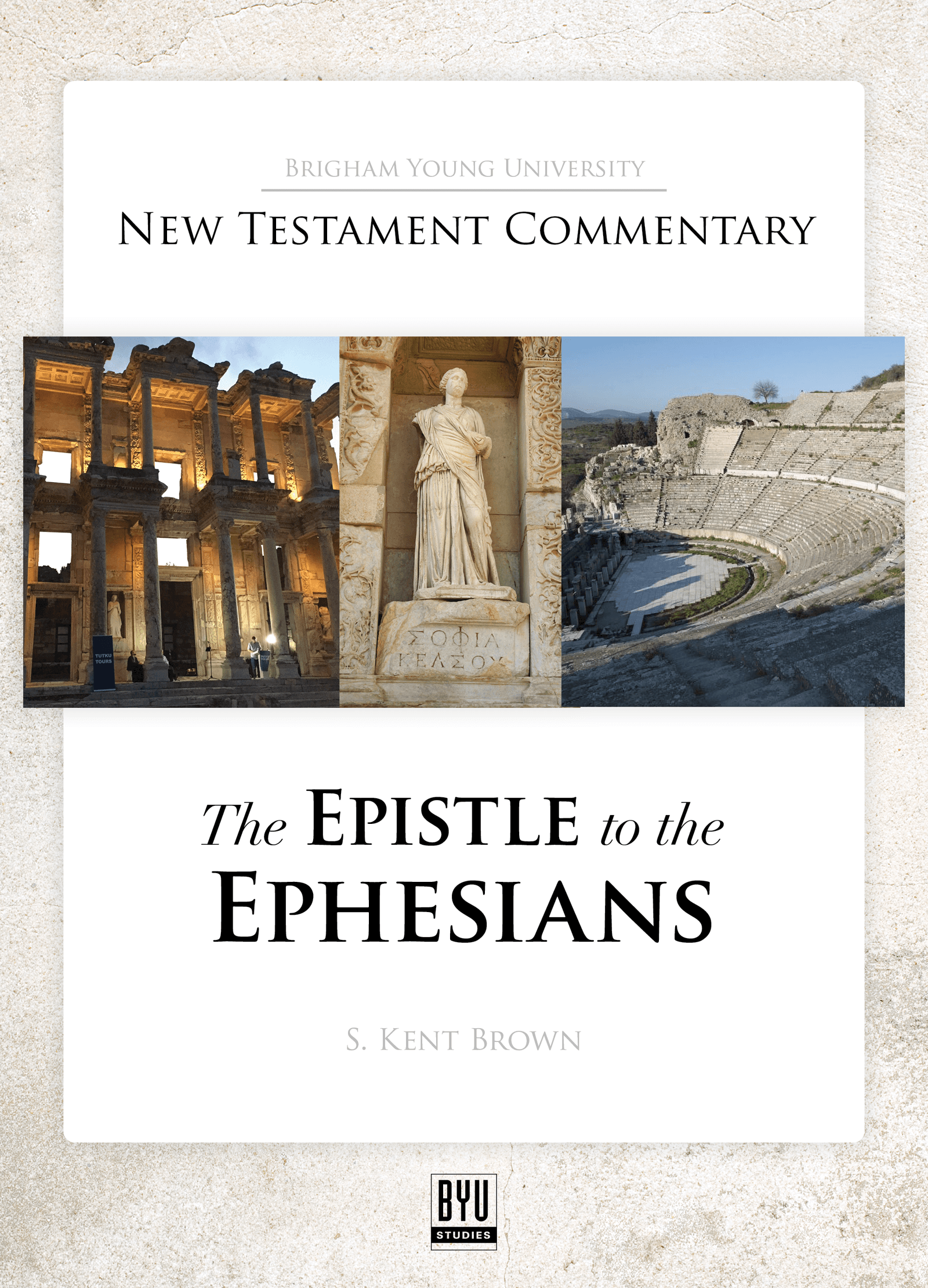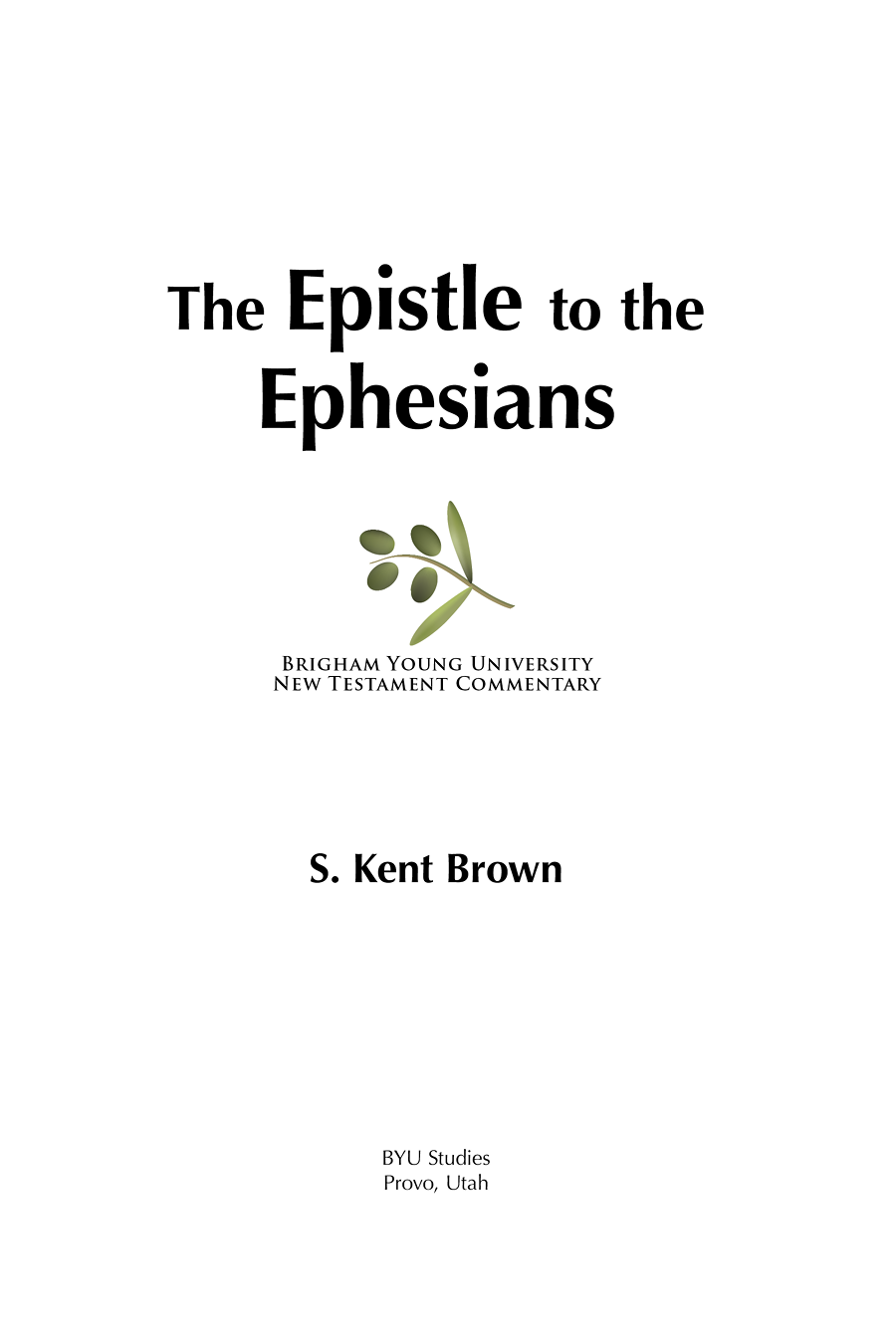Other books in the BYU New Testament Commentary series
The Gospel according to Mark by Julie M. Smith
The Testimony of Luke by S. Kent Brown
Pauls First Epistle to the Corinthians by Richard D. Draper and Michael D. Rhodes
Epistle to the Hebrews by Richard D. Draper and Michael D. Rhodes
The Revelation of John the Apostle by Richard D. Draper and Michael D. Rhodes
This Commentary Series is made possible by a generous gift from John S. and Unita W. Welch. This volume received a generous grant from Belva and David Stone.
Published by BYU Studies. To contact any member of the board of editors or BYU Studies, write to 1063 JFSB, Brigham Young University, Provo, Utah, 84602, or visit http://byustudies.byu.edu or http://www.byunewtestamentcommentary.com.
Cover images: Left: Library of Celcus at evening, Ephesus, photo by S. Kent Brown. Center: Sophia (Wisdom) in the Celsus Library in Ephesus, Jos Luiz Bernardes Ribeiro / CC BY-SA 3.0. Right: amphitheater in Ephesus, photo by S. Kent Brown.
First time in print. Substantive corrections, additions, questions, or comments may be sent to .
Library of Congress Cataloging-in-Publication Data
Names: Brown, S. Kent, author.
Title: The Epistle to the Ephesians / S. Kent Brown.
Other titles: New Testament commentary (Brigham Young University)
Description: Provo, Utah : BYU Studies, [2023] | Series: Brigham Young University New Testament commentary series | Includes bibliographical references and index. | Summary: A verse-by-verse commentary on the New Testament Epistle to the Ephesians. Provides a modern English version of the text. Cites scriptures of The Church of Jesus Christ of Latter-day Saints (Mormons). Focuses on Jesus Christ and the unity and steadfastness of believers -- Provided by publisher.
Identifiers: LCCN 2022031818 | ISBN 9781942161974 (hardcover) | ISBN 9781942161981 (ebook)
Subjects: LCSH: Bible. Ephesians--Commentaries. | Church of Jesus Christ of Latter-day Saints--Doctrines. | Mormon Church--Doctrines.
Classification: LCC BS2695.53 .B76 2023 | DDC 227/.507--dc23/eng/20220909
LC record available at https://lccn.loc.gov/2022031818
About the Brigham Young University New Testament Commentary Series
Welcome to the BYU New Testament Commentary, a project by a group of Latter-day Saint specialists offering to readers a careful, new look at the biblical records that witness the life and ministry of Jesus Christ and the first generation of his church. The commentary series seeks to make the New Testament more accessible to Latter-day Saint general readers and scholars by employing much of current biblical scholarship while reflecting important LDS insights. At the same time, this effort may also be helpful to interested readers of other faiths who want to learn how a group of Latter-day Saint scholars understands the Bible. A fundamental article of faith for Latter-day Saints (Mormons) affirms the Bible to be the word of God while adding, understandably, that it needs to be translated correctly in order for it to be accurately comprehendible to modern language speakers.
These objectives have helped shape the purposes and parameters of this commentary series. Serious LDS readers of the Bible search the scriptures, looking for depth and breadth in passages whose meanings and mandates may ultimately be plain but not shallow. Such readers and interpreters are served by treatments that unite faith and research, reason and revelation, in prayerfully confronting profound and difficult issues that arise in the texts and affect ones path of progression. The New Testament has served as an influential guide to western civilization for centuries. As such, its records have long been studied by lay people and scholars alike, resulting in a rich reservoir of information that illuminates the New Testament era culturally, historically, and linguistically. Selectively, the BYUNTC builds upon this vast body of knowledge, resting on the Greek texts of the New Testament and connecting helpful elements of linguistic, literary, historical, and cultural research and traditional scholarship together with LDS scriptures and doctrinal perspectives. The combination of all these features distinguishes the BYUNTC from other commentaries, which are readily available elsewhere and which readers may also want to consult for more encyclopedic or specialized discussions.
The tone of the BYUNTC aims to be informative rather than hortatory, and suggestive rather than definitive in its interpretation. The opinions expressed in this series are the views of its contributors and should not necessarily be attributed to The Church of Jesus Christ of Latter-day Saints; Brigham Young University, where many of those involved here are headquartered; or anyone else, though these works have benefited from input and guidance from a number of colleagues, advisors, editors, and peer reviewers.
Each volume in this series sets in two parallel columns the King James Version (KJV) and a new working translation of the New Testament. Calling this a new rendition clarifies that it does not seek to replace the authorized KJV adopted by the LDS Church as its official English text. Rather, it aims to enhance readers understanding conceptually and spiritually by rendering the Greek texts into modern English with LDS sensitivities in mind. Comparing and explaining the New Rendition in light of the KJV then serves as one important purpose for each volumes notes, comments, analyses, and summaries. This effort responds in modest ways to the desire President J. Reuben Clark Jr. expressed in his diary in 1956 that someday qualified scholars [would provide]... a translation of the New Testament that will give us an accurate translation that shall be pregnant with the great principles of the Restored Gospel.
Depending on their personal skills and interests, the authors of these volumes approach their scholarly sources and LDS materials differently but always with careful exposition and engaging perspectives. In several ways, they employ various interpretive tools, including semantic considerations of Greek vocabulary; cultural, historical, critical, literary, and structural analyses; and intertextual comparisons with other biblical passages, the Book of Mormon, and other scriptural works including the Joseph Smith Translation of the Bible. Observations are also proffered about the doctrinal and spiritual reception of New Testament teachings and practices in the broad LDS religious tradition.
The format also varies moderately from volume to volume regarding introductory materials and the style of commentary. Throughout, Greek and Hebrew terms appear in transliterated form in conformity with standards adopted by the Society of Biblical Literature. In some cases, a volume reproduces the Greek New Testament text based on the Greek text published by the Society of Biblical Literature (2010) or draws upon the twenty-eighth edition of the Nestle-Aland text in Novum Testamentum Graece (2012).
Contents
Abbreviations
For ancient works, the footnotes follow the style of Patrick H. Alexander and others, The SBL Handbook of Style for Ancient Near Eastern Biblical and Early Christian Studies (Peabody, Mass.: Hendrickson Publishers, 1999).
ANF | Roberts, Alexander, James Donaldson, and A. Cleveland Coxe, eds. The Ante-Nicene Fathers: Translations of the Writings of the Fathers down to A.D. 10 vols. Reprint. Grand Rapids, Mich.: Eerdmans, 1950. |


